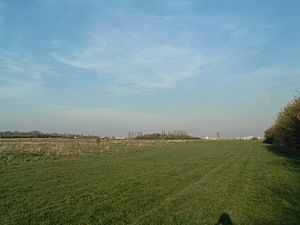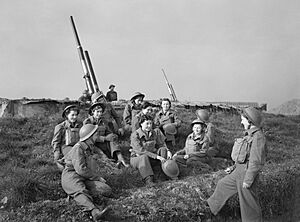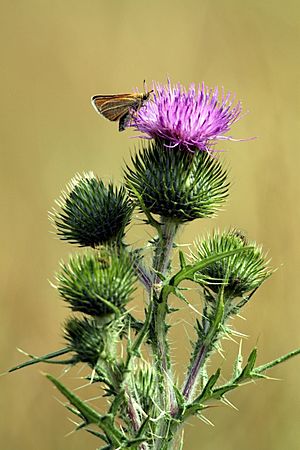Wormwood Scrubs facts for kids
Wormwood Scrubs, often called The Scrubs by locals, is a large open space in west London. It's found in the north-eastern part of the London Borough of Hammersmith and Fulham. This area is the biggest open space in the borough, covering about 67 hectares (166 acres). It's also one of London's largest areas of common land, meaning it's land that everyone can use. A railway line and Scrubs Lane separate the eastern part, known as Little Wormwood Scrubs, from the main area. Wormwood Scrubs has been a public space for everyone to enjoy since 1879.
On the southern side of The Scrubs, you'll find two important places. To the west is Wormwood Scrubs Prison, which was built between 1875 and 1891. East of the prison is the Hammersmith Hospital campus, which also includes the Queen Charlotte's and Chelsea Hospital.
The Scrubs is home to many sports facilities. These include the Linford Christie Stadium, lots of football pitches, and even a pony centre. The football team Queens Park Rangers used to play on Wormwood Scrubs from 1893 to 1896.
Contents
History of Wormwood Scrubs
The area was first mentioned in 1189 as Wormhold Scrubs. Back then, it was a cleared woodland used for grazing cattle and pigs. In 1801, the northern part was separated by the building of the Paddington Arm of the Grand Junction Canal.
Military Use and Public Access
In 1812, the War Office (which managed the army) leased about 77 hectares (190 acres) of Wormholt Scrubs. They used it to train cavalry horses, which had previously trained in Hyde Park and Regent's Park. This common land then became known as Wormwood Scrubs.
Later, railway lines cut off more parts of the land. The London and Birmingham Railway took a section in 1837, and the Great Western line took another in 1838. In 1844, the Birmingham, Bristol and Thames Junction Railway cut off a large part of the eastern half, which became Little Wormwood Scrubs.
In 1872, the military bought the rights to the land to create a military training ground. However, the Wormwood Scrubs Act 1879 was passed to make sure the land was also kept as a "metropolitan exercising ground" for the military and for "the perpetual use by the inhabitants of the metropolis for exercise and recreation." This law meant the military could use the land for training, but people could use it freely when they weren't. To keep it open, the law banned the military from building any permanent structures except for rifle butts. One of these rifle butts still exists today as a wall in the Linford Christie Stadium.
In 1873, the southern part of The Scrubs was bought to build Wormwood Scrubs Prison. In 1889, land next to the prison was bought for Hammersmith hospital.
Wormwood Scrubs in the 20th Century
In 1908, the Olympic Marathon race route crossed The Scrubs. The race started at Windsor Castle and finished at the White City Stadium in White City.
Wormwood Scrubs also played a part in early aviation history. In 1910, a pioneer airship took flight from a temporary landing area. Soon after, a special airship garage was built. Today, the Linford Christie Stadium stands on this site. By 1914, all air-related activities on The Scrubs were managed by the Admiralty. Records show there was a base called Wormwood Scrubs Naval Air Station. The airship shed was used to train armoured car crews for the Royal Naval Air Service. It remained an emergency landing ground until the 1930s.
During World War II in 1939, Wormwood Scrubs was home to a secret military department. This was the Chief Cable Censorship Department, which was linked to the Government Code and Cypher School (GC&CS) at Bletchley Park. This department helped with code-breaking efforts.
A railway station called St. Quintin Park and Wormwood Scrubs railway station used to serve the area. On October 3, 1940, during World War II, the station was hit by a bomb and destroyed by fire.
In 1986, a local birdwatcher named Lester Holloway started a campaign. He wanted to save Scrubs Wood, an area of railway land, from being destroyed by plans to build train cleaning depots. Lester and his campaign fought for this, and they won some important agreements. Today, a nature reserve there includes an area known as 'Lester's Embankment'.
Nature and Wildlife at Wormwood Scrubs
Parts of Wormwood Scrubs are protected as a local nature reserve. These special areas include Braybrook Woods, Martin Bell's Wood, and the Central Woodland Copse. They have different types of habitats like woodlands, scrubland, and grasslands.
Animals and Plants
You can find many different animals here, including common lizards, over 100 types of birds, and 20 different kinds of butterflies. This area is looked after by the London Borough of Hammersmith and Fulham along with Groundwork UK.
Conservation Efforts
Work is being done to help the wildlife at Wormwood Scrubs. The main goal is to connect the different parts of the Local Nature Reserve with "wildlife corridors." These are like pathways made of low hedges and trees. The idea is that this will help the different plants and animals, especially bats like the common pipistrelle, find food and move around the park more easily.
Efforts are also being made to improve the homes for the local common lizards. This includes removing some scrub to create sunny spots where the lizards can warm themselves. This work also involves planting new trees. Volunteers from Groundwork London help with much of this conservation work.




